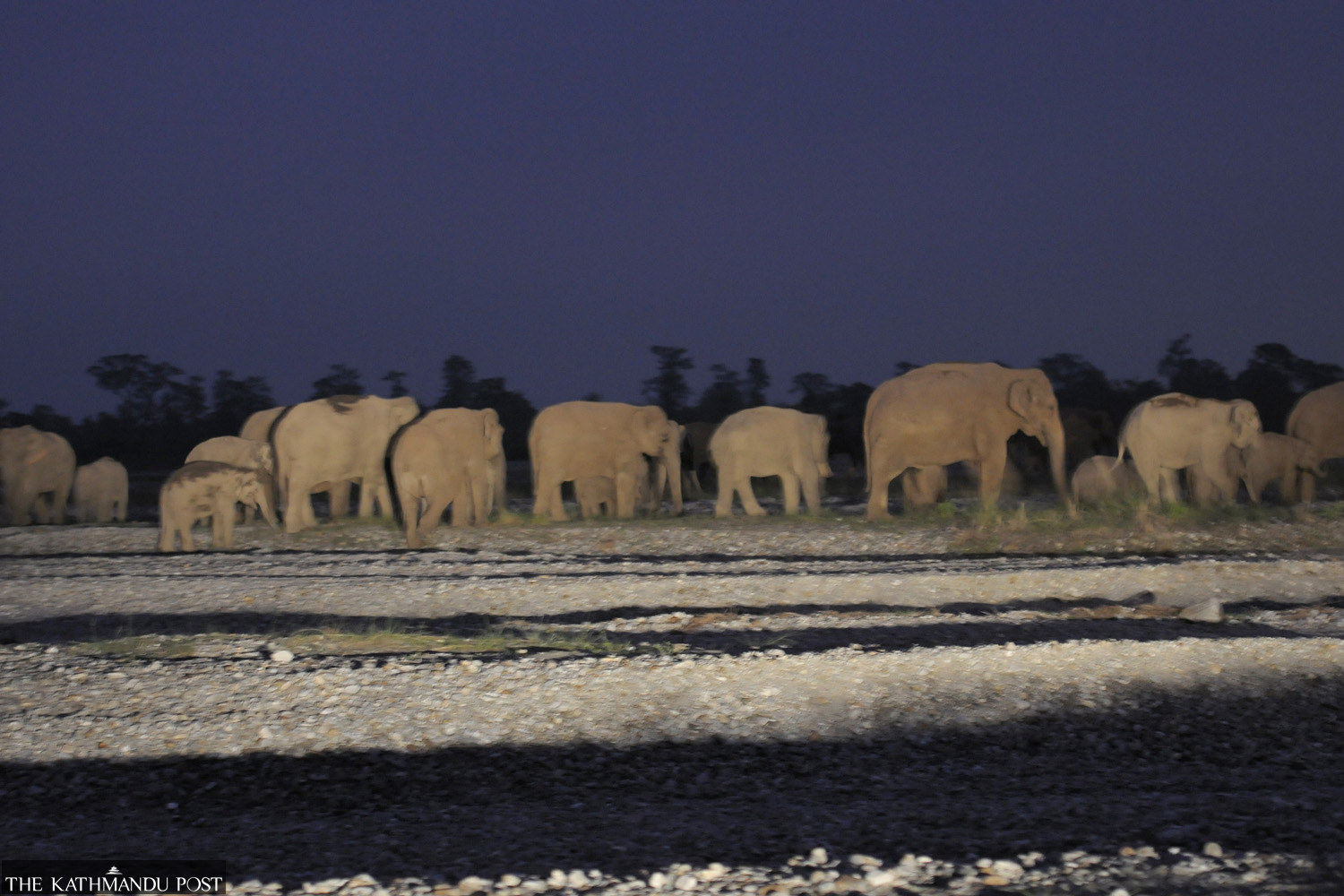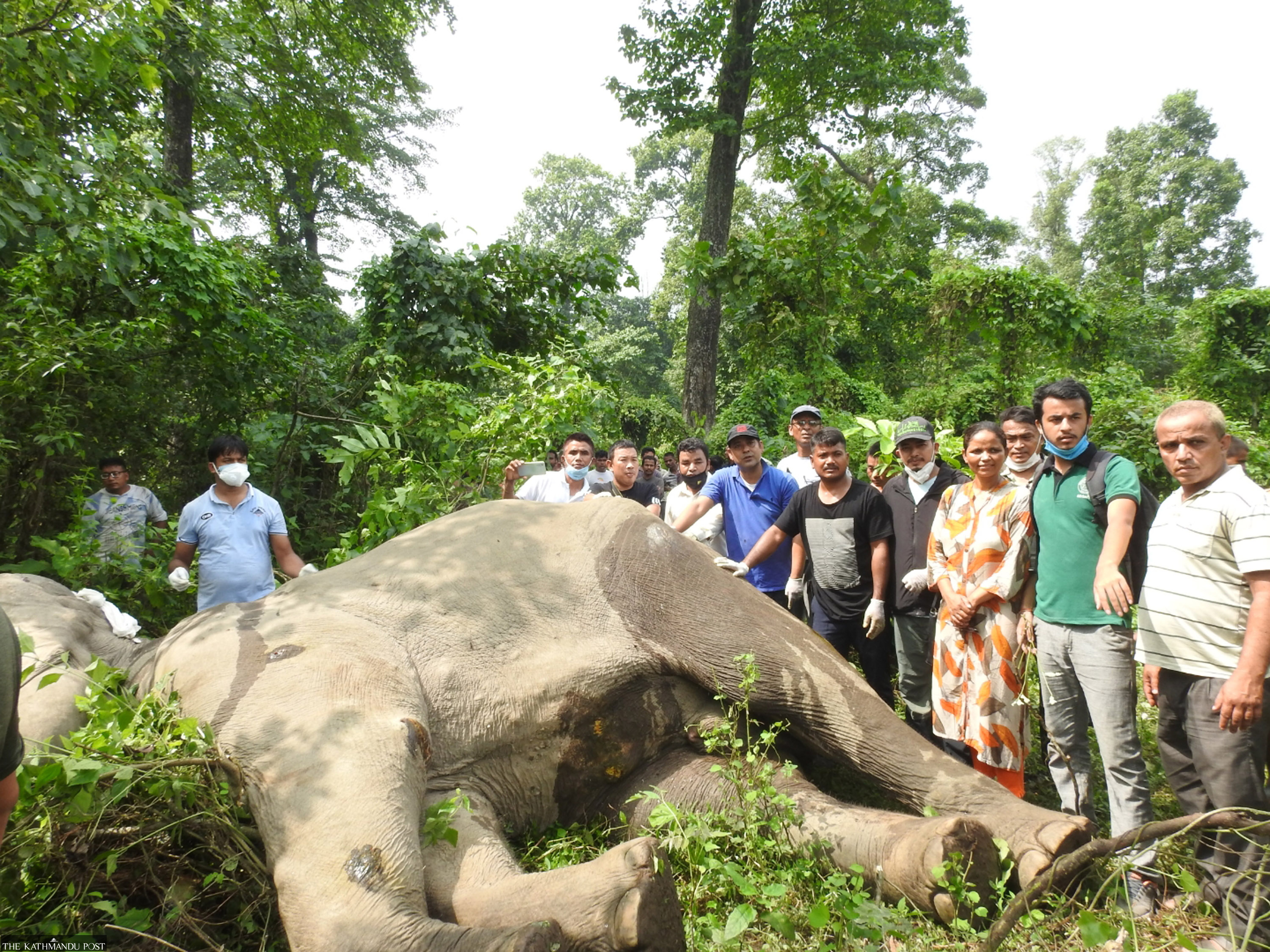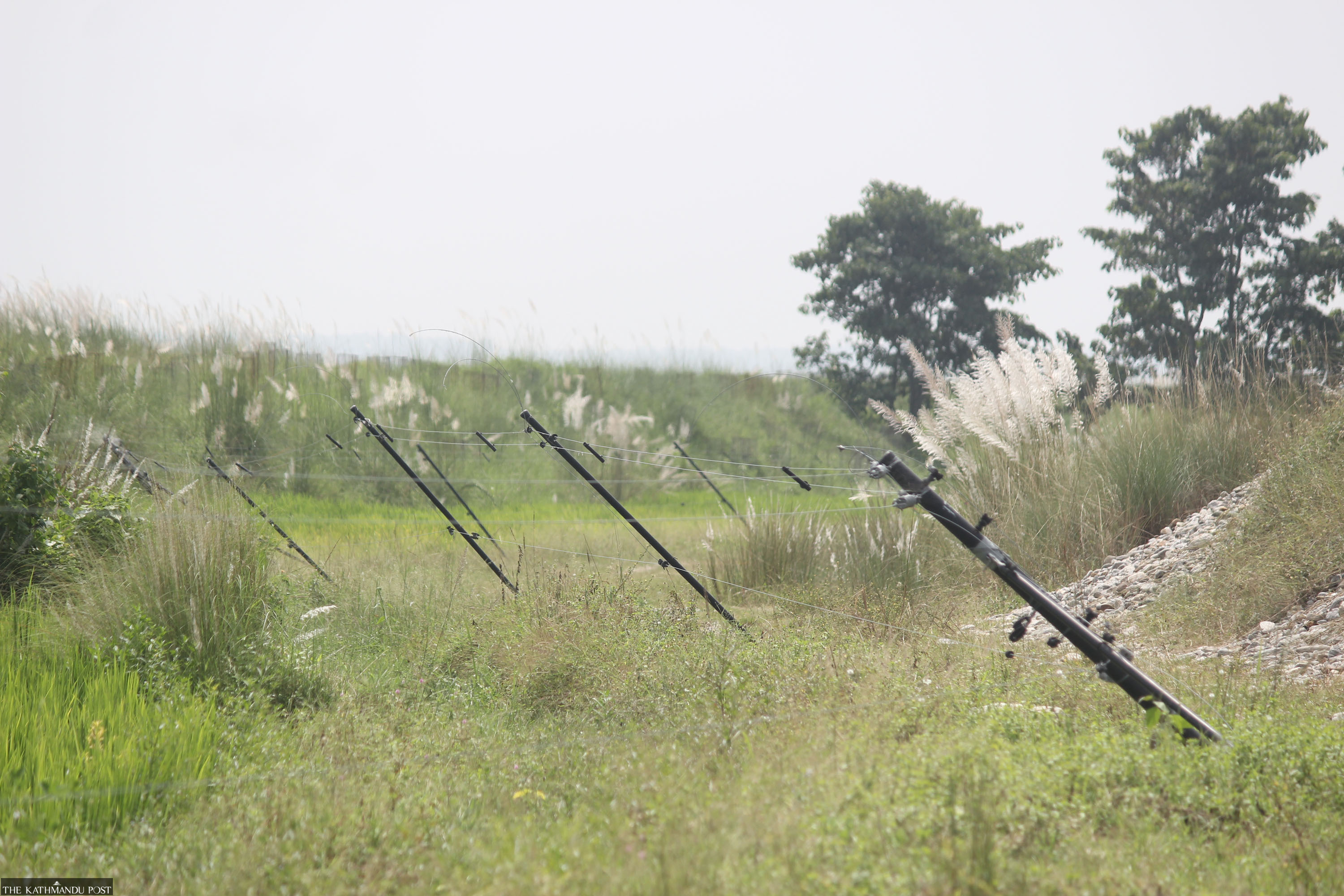National
An old battle of wills playing out in Jhapa
The district’s decades-long human-elephant conflict calls for a more sustainable solution rather than the ad hoc measures currently being adopted..jpg&w=900&height=601)
Sudheer Sharma
If you look at Nepal’s map, on its far-eastern corner lies the Kakarbhitta border point, which was recently connected to the six-lane Asian Highway. Moving forward by crossing the Mechi river, one gets to Siliguri in India and from there on to the state of Assam and Myanmar. Bangladesh is about 20-22km east, and Bhutan, a bit further up. But we aren’t going in that direction; we are rather heading up north, along the Mechi banks in Jhapa district.
After travelling a little, we see something strange. About 18km of borderline with India is fenced with wire, where electric current is transmitted at all hours. But this fence on the international border is not there to stop people; it has instead been erected to protect them.
Even though armed conflicts in Nepal are consigned to history, this is an area where conflict of a different sort has been simmering since well before the insurgency. This is a story of conflict between wild elephants and humans that has claimed the lives of at least 55 people and 15 elephants, and has left dozens injured over the years.
Silence and fear have gripped human settlements in the area with the wild, marauding elephants going on the rampage.
The challenge is how to better tame the pachyderms. The fence was erected to prevent wild elephants getting closer to the humans, but that doesn’t seem to have worked. Apparently, hundreds of elephants tore down the fence and broke into human settlements, destroying crops and going on a killing spree.
“Previously, lighting up incense sticks and blowing conches would be enough to force the elephants to retreat,” recalls Sukumar Pradhan, a resident of Bahundangi. “Firecrackers would also do the job. But once they proved ineffective, we started lighting up a blaze. But, now instead of retreating, they come towards fire, and not even an inferno deters them.”
Only last month, there were two elephant-related incidents—a 34-year-old woman, who was returning home through the Thoplebiran community forest in Mechinagar Municipality-9 on her scooter, was killed in an elephant attack; then another person, an 80-year-old man from Bahradashi Rural Municipality, was crushed to death.
For Jhapa residents, elephant attacks have become fait accompli.

A routine replete with terror
One gets a sense of that quickly after heading a little north from Kakarbhitta. Elephant menace has become a matter of daily challenge in areas such as Nakalbanda—which was an eastern border point before the Mahendra Highway was built and hosted the Rana-era customs office. That has since been converted into an armed police post that patrols settlements higher up such as Bahundangi, Aaldangi, Bhorleni and the upper reaches of the Mechinagar Municipality.
On the eastern flank of this area lies India’s Naxalbari, the epicentre of the communist revolt led by Charu Majumdar that started in 1967, whose ripple effects had also been felt across the border. Previously, if it was a ‘revolution’ that had arrived from India, now it’s herds and herds of elephants streaming into Nepal undaunted.
“The situation is such that the people can’t even stay home during festivals like Dashain and Tihar,” Rajan Dahal, a local of Bhorleni, said. “When dusk sets in, the locals have to head to the farmlands and stay there in a makeshift tent, to keep track of elephants. If the elephants come, we have to make noises to scare them away. And if that doesn’t work, we run away. There’s no other option.”
Dahal himself lost his father in 2003 when an elephant mauled him to death while he was chasing it away. Their threat continues to haunt.
The locals have tried to find solutions. They have constructed watchtowers across the area. Recently, an early warning system was built in an armed police post in Bahundangi. On detecting an elephant, the officers set off a siren, which produces sound that is audible for up to 1km. A mobile app called ‘Hatti Aayo’ has also been developed. Whenever someone detects elephant movement, they punch the information into the app, which in turn notifies the officers, who then blow the siren.
Almost all the houses in the area appear to have wire fences around them as a precautionary measure. “When we know of elephant movement, we pass electric current on the fence,” said Chandra Thapa, an elderly woman from Aaldangi. “We’d rather do that than die.”
But such measures haven’t stopped the loss of lives and properties. Most people who lost their lives in elephant attacks were destitute, and largely subsisted by farming.
Nobody in the area seems to have been spared the impact of elephant attacks. The attacks resulted in a loss of crops or worse, damage to their homes.
There are also some indigenous elephants that attack places with abundant fodder. “Which home has food and where—they know everything,” said Arjun Karki, ward chair of Mechinagar-4. “Where there’s paddy, they attack it and feed on the grains. When they don’t get anything good to feed on, they destroy the kitchen, utensils and clothes and whatever else they can find really.”
So much so that if a family brews jaad and raksi, the elephants break into the house to ingest the alcoholic beverages. “Elephants are known to love alcohol. There’s even an incident when they entered a bhatti [local pub],” Karki claimed. “The elephants get inebriated after drinking. In 2003, one such intoxicated elephant killed three people in Aaldangi.”
Of those killed, two were newly-wed bride and groom—Shambhu and Durga. Jagmaya, Shambhu’s mother, gets disturbed even today when she reminisces about that fateful night. An elephant had dragged her 22-year-old son and daughter-in-law right out of the bed, at midnight. “I could only shout to wake them up. The elephant barged into the room and took them away,” recalled Jagmaya, seated at her house’s porch, her eyes welling with tears. “Even today, I get afraid when it’s night, anxious if an elephant might come and kill me.”

‘The elephant has no nationality’
Shankar Luitel of Bahundangi has a daily routine of trekking to the Mechi banks in the morning, observing elephant behaviour at dusk and taking photos, if he can. For years, he has been studying elephant habitat and behaviour and counting their population. This interest has taken him to jungles in areas as far as Bardiya, Chitwan, North Bengal and Assam, working with several elephant researchers.
In Luitel’s understanding, the elephants have for long been travelling from Assam’s Kaziranga National Park to Koshi Tappu Wildlife Reserve. Elephants have been grazing in this 700km area from Brahmaputra to Koshi, for centuries. Some elephants come even from the jungles of Bhutan and Bangladesh. Because of their sharp memory, elephants almost never forget their old route.
“We found out that the elephants in and around Kaziranga move out from the area after April,” Luitel said. “In about two and a half months, they arrive at Mahananda Sanctuary, and then enter Nepal. Then, after a few months, they return. But this route has now been trespassed, for two reasons.”
First, there has been massive deforestation in the jungles that fall on the route. And, second, further destruction of animal habitat when armed separatist groups started terrorising the jungles of Assam and security personnel undertook a counter-offensive. The elephants from Kaziranga then found a safe haven in the jungles of North Bengal and Nepal.
“It is the same elephants that roam around the border,” Luitel said. “They find their fodder here and so they tend to stay on. In the 1990s, North Bengal was home to only about 150 elephants, but that number has increased to around 700 now. When the number was low, they needed less fodder and a small jungle would do. But as their numbers increased, they needed more and more. The human population increased as well and, naturally, the conflict escalated.”
This brings up the question: does this place belong to humans or elephants? Perhaps for the elephants, as it’s part of their centuries-old route, humans have no right to encroach on it. The frustrated people, meanwhile, struggle to understand why these elephants frequently visit their homes and fields.
“We humans believe that this is our place. That’s why, when we see an elephant, we immediately try to chase it away,” Karki, the Mechinagar-4 ward chair, said. “Those attempts upset the elephants. And that has been leading to conflicts.”
According to Karki, as there are many security camps, big tea estates, and urbanisation too is on an upward trend on the Indian side, the elephants stray into Nepal in search of fodder. “Unwilling to deal with the elephants and fed up with the locals’ complaints, the Indian security personnel these days chase the elephants to the Nepali side when it’s dusk,'' Karki claimed.
And herein is the second aspect of the conflict—do the elephants belong to Nepal or India? Nepalis believe the elephants are Indian; Indians claim they are of Nepali origin.
Truth be told, the elephants have neither citizenship nor nationality. They have been patrolling this area long before the borders were drawn.

Co-existence or revenge?
There’s also a third aspect to the conflict—the locals are divided on how to tackle the menace. One faction believes in exacting revenge against the elephants, the other on peaceful co-existence.
According to the local elderly people, the frequency of elephant attacks increased from around 1994. From 2006-07, the situation started spiralling out of control.
As elephant attacks increased, the villagers began to harbour a grudge against the wild animals. Incidents wherein the locals beat up, abused and even killed the elephants became more frequent. “The elephants get furious when they are abused,” said Karki, the ward chair. “There are often hundreds of people chasing a single elephant. Then that elephant gets scared and begins to indiscriminately attack and kill people. The crowd of people who get together to chase away the elephant also end up destroying the crops. This is not how the problem is solved.”
After founding a nature conservation society, the locals first tried to lower the anger of humans towards elephants. They took to the streets, demanding compensation and relief for the victims. After widespread pressure, the cabinet in 2011 endorsed a directive to provide relief to the victims of human-wildlife conflicts.
The concept of wire-fencing originated locally. Two individuals, Shankar Luitel and Manoj Thapa, who had observed the fencing model at Mahananda Wildlife Sanctuary and Doors area in India, had proposed it back in 2007. Accordingly, a 14km long wire fence was erected by the then District Development Committee, but it proved to be ineffective in the absence of regular monitoring.
After that experience, the World Bank started exploring new ways of tackling the issue. With its financial aid, the National Trust for Nature Conservation built a 17.14km fence in 2015, spreading from Mechi Municipality-6 to Rong Rural Municipality in Ilam. The fence is supplied with electric current throughout the day via solar panels erected at every one kilometre. The poles and wires appear to be tilted towards the Indian side, so as to keep the elephants from crossing the fence.
According to locals, in the early days, the fence had worked. The phenomenon of elephants entering in herds had decreased, even if the indigenous elephants would cross over. This year, however, hundreds of elephants barged in again, rendering the fence ineffective.
In the past, the then seven-party alliance had tasked an organisation called Human-Elephant Conflict Management and Environment Conservation Forum with monitoring and maintenance of the fence. It had an endowment fund of Rs3 million. But these days, the ill-maintained fence is damaged in places, locals complain. The fence also includes 15 gates for human movement, but there have been incidents when the officials have forgotten to lock the gates at night, allowing the elephants to pass through. Smugglers who are active around the border also sometimes leave the gates open.
Most worryingly, the elephants have begun to tear apart the fence. Hikmat Thapa, a local, said, “At around 3am one moonlit night when we were keeping watch, we witnessed an elephant trying to take the fence apart with one of its tusks. After repeating the action four times, there was a short-circuit and a flash of fire. It turned out the elephant tusk doesn’t transmit current. It then crossed over to the Nepali side, jumping over the fence.”
According to experts, there is no one good way to solve the pachyderm problem. Whatever humans do, elephants in due time find a way to circumvent that. Then the humans are forced to come up with new measures.
“A more sustainable solution would be figuring out ways to ensure a peaceful co-existence,” Luitel said. “My father used to try to scare the elephants away by burning fire, which I also continue to do. My son would be forced to do the same if we don’t look for a sustainable solution now.”

The government doesn’t pay heed
Yam Bahadur Subedi is one of 12 technicians deployed to monitor the solar fencing. One morning last December, while returning home after checking the fence, he came face to face with an elephant. “I was alone and I couldn’t run. The elephant mauled me and threw me away. Thankfully, I didn’t die, as the villagers came to my rescue right away,” said Subedi.
Even though he survived, 11 of his rib bones were broken. He had to stay at the hospital for 23 days and spent around Rs600,000 on treatment. He did get some government help after 10 months: a lump sum of Rs200,000. “When something like this happens, neither the government nor any organisation comes to our help. In this situation, how are we supposed to work to keep the elephants away?” he asked.
According to the directive the government issued in 2011, a badly injured victim in human-elephant conflict gets up to Rs200,000 in relief. Meanwhile, the family of the deceased gets up to Rs1 million. If the elephant destroys the crops, or damages the house, cattle sheds or the silo, the victims get up to Rs10,000.
The compensation is not only insufficient, it’s also difficult to come by, with the victims being forced through several administrative hurdles to get it. For most residents, the compensation amount doesn’t even cover the cost of visiting the district headquarters.
Moreover, the victims get the relief amount only after 8-10 months of the incident. Were the amount to be released by the respective local unit, the process might be a touch easier for the victims. The locals also say a team of the Forest Office should be nearby, so that the victims get rescued in time and the relief is distributed quicker.
With elephants destroying paddy all the time, farmers have switched to growing tea; the number of those into betelnut farming is also sizable. But as the government directive left out plants like betelnut, tea, and garlic, damage to those crops is not being compensated.




 10.12°C Kathmandu
10.12°C Kathmandu
%20(1).jpg&w=200&height=120)














